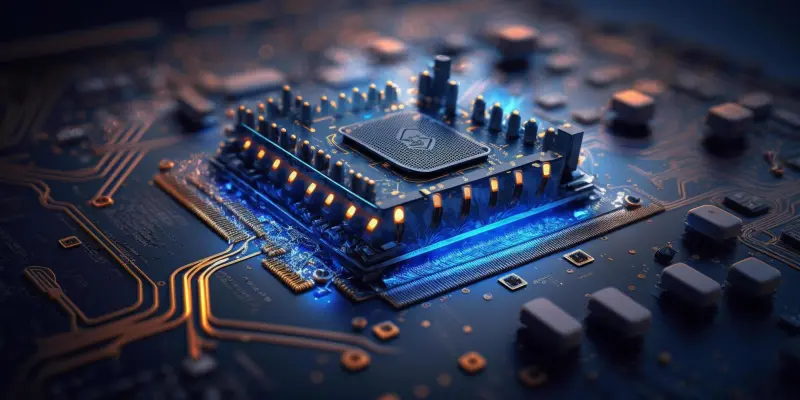Nvidia is spearheading a transformative era in AI semiconductor integration, a development that has sent ripples across the tech landscape. This monumental shift was articulated by CEO Jensen Huang during the recent Computex event in Taiwan, one of the world’s foremost electronics forums. However, the announcement wasn’t merely a proclamation of new products but rather a significant pivot in Nvidia’s overarching strategy. Pioneering initiatives like the NVLink Fusion system have been unveiled, aiming to merge Nvidia’s high-speed interconnects with chips from various manufacturers. This decisive move signals a departure from Nvidia’s previous approach of constructing complete systems exclusively with its proprietary hardware. By opening its ecosystem to external collaboration, Nvidia is addressing the evolving needs of tech giants like Microsoft and Amazon, who are deepening their semiconductor capabilities in-house. These giants, alongside a host of other enterprises, are seeking more flexible, efficient AI infrastructures to support their expansive operations.
Nvidia’s Strategic Shift and Industry Response
Nvidia’s introduction of the NVLink Fusion system marks a revolutionary leap that holds profound implications for the AI semiconductor industry. It represents not just an enhancement in technology but a strategic maneuver to secure Nvidia’s relevance in a rapidly evolving market. By enabling customers to integrate Nvidia’s AI chips with third-party semiconductors or their own CPUs, data centers can achieve unprecedented levels of customization and flexibility. This approach is especially appealing to hyperscale companies that strive for self-sufficiency in their operations. As the global tech landscape grapples with challenges such as geopolitical trade tensions and supply chain uncertainties, Nvidia’s openness to collaborative ecosystems underscores its commitment to adaptability. The acknowledgment of these challenges was apparent in Huang’s presentation, highlighting how the NVLink Fusion can address core issues while maintaining Nvidia’s competitive edge. This strategy reflects a nuanced understanding of the market’s demands, positioning Nvidia as a key player in shaping the future of AI-driven solutions.
Enhancing AI Capabilities and Market Repercussions
With the introduction of new systems like the RTX Pro Server and DGX solutions, Nvidia is reinforcing its leadership in AI, catering to the growing demand for advanced computational power. These products are designed to accelerate AI services and boost data center capabilities. By offering blueprints for AI “factories,” Nvidia helps businesses harness expansive AI potential efficiently. Amid this progress, market players are keenly observing Nvidia’s impact on stock markets, particularly given the company’s significant partnerships with leading tech firms. The willingness to engage with competitors signifies a bold step, resonating across the industry. Such collaborations not only broaden Nvidia’s technological scope but also elevate its standing in an industry leaning towards modularity and interoperability. Market reactions are inevitably mixed, as stakeholders weigh the benefits of expanded access against potential dependencies on Nvidia’s ecosystem. This strategic opening aligns with a broader industry trend favoring versatility, marking a pivotal point in AI semiconductor integration.
Future Orientation and Technological Collaborations
As Nvidia continues its journey, the focus remains on building partnerships and regional expansions, particularly in collaboration with Asian manufacturers. The partnership with Taiwanese suppliers and the government to create an AI supercomputer exemplifies Nvidia’s proactive regional strategy. Such initiatives strengthen Nvidia’s foothold, ensuring an expanded reach and influence in the global market. Furthermore, alliances with companies like MediaTek, Marvell, and Qualcomm demonstrate Nvidia’s commitment to fostering innovation through collective expertise. By leveraging these collaborations, Nvidia can navigate uncertainties and achieve sustained growth. The NVLink Fusion and associated developments are more than mere technological advancements; they represent a forward-looking commitment to enhancing data center efficacy and AI capabilities. Despite potential complexities in dependence dynamics, Nvidia continuously adapts its ecosystem to offer customized AI solutions that align with clients’ evolving needs. This forward-thinking approach suggests Nvidia’s capacity to remain a central figure in AI semiconductor innovations.
Conclusion: Sustained Relevance and Future Challenges
Nvidia is at the forefront of a groundbreaking revolution in AI semiconductor integration, creating a buzz throughout the tech sector. This significant transition was articulated by CEO Jensen Huang at Computex in Taiwan, a key event in the electronics arena. Unlike typical announcements, this was not just about unveiling new products but marked a strategic shift for Nvidia. Among its innovative projects is the NVLink Fusion system, designed to integrate Nvidia’s high-speed interconnects with chips from other manufacturers. This represents a departure from Nvidia’s former practice of building complete systems with solely its proprietary hardware. By broadening its ecosystem to include external partnerships, Nvidia caters to the changing demands of tech giants like Microsoft and Amazon, which are enhancing their internal semiconductor capabilities. These companies, along with many others, are searching for more adaptable and efficient AI infrastructures to support their vast operations and continued growth in the tech field.

